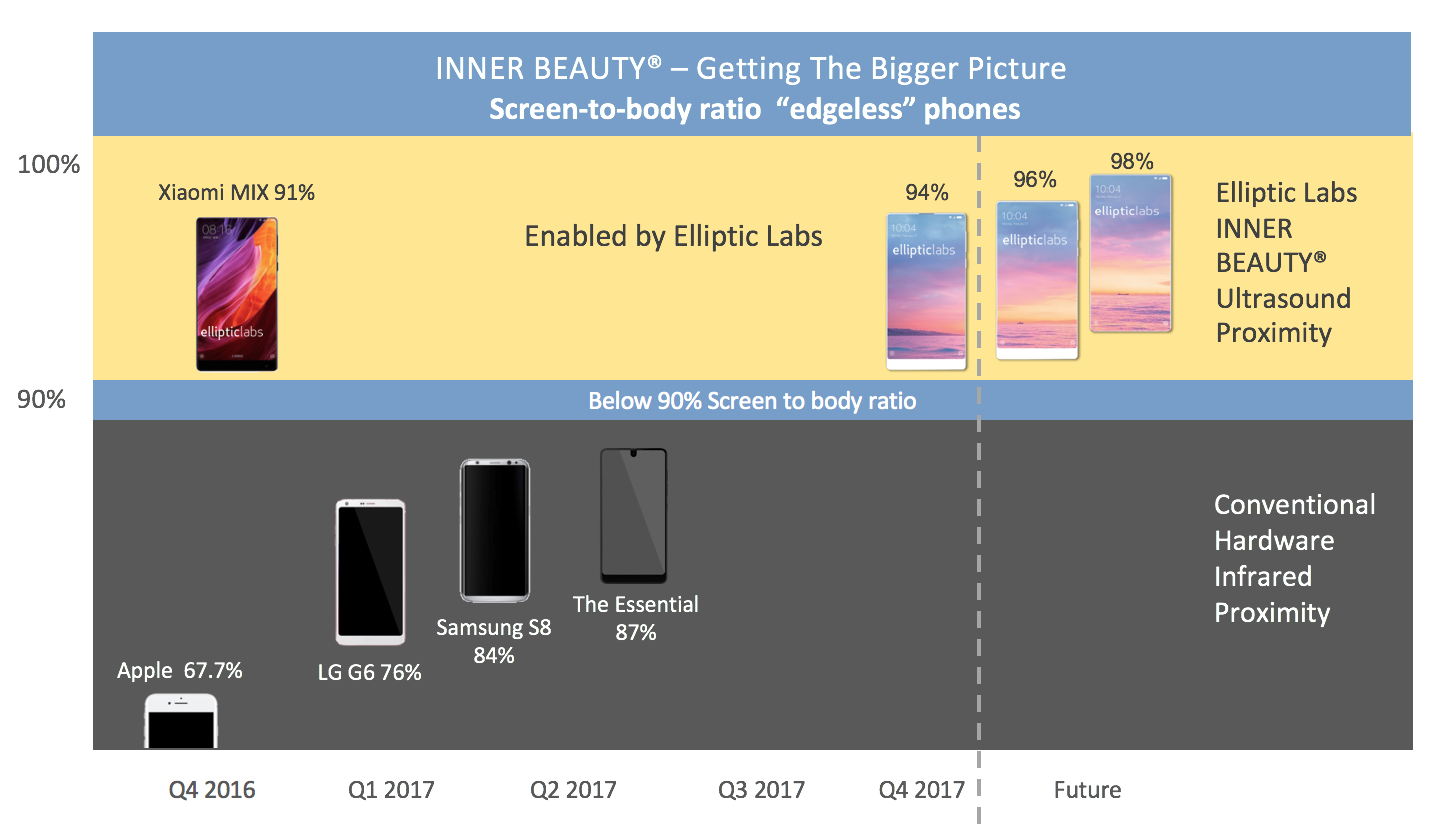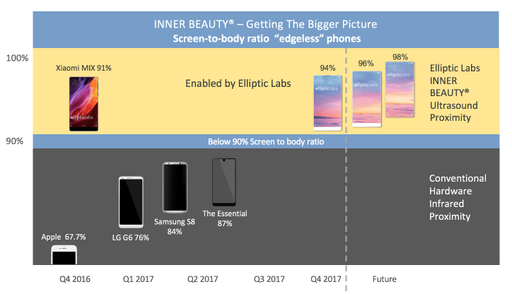Are you really getting the bigger picture? According to Samsung, "Infinity Screen" means just 84% of total screen-to-body ratio. Over at LG, the "Full Vision" screen on their latest phone, the G6, has a functional area that covers only 79% of the total screen. Lenovo's ZUK Edge still has an edge — as in, a bezel — because its screen-to-body ratio tops out at 86.4%. The point here is that size matters when it comes to claiming more screen area on mobile phones. Xiaomi's Mi MIX disrupted the market last year with the first and largest screen-to-body ratio to date: over 91% in an almost bezel-less phone. In comparison, the iPhone 7 Plus screen utilizes just 67.7% of the front body.
Consumers clearly want larger, functional screens, but manufacturers trying to maximize screen real estate have an uphill battle if they're using conventional infrared technology. That's why Xiaomi leveraged Elliptic Labs' INNER BEAUTY® ultrasound software to kick off a new smartphone design trend we identified last year. (See article.) Now, it's become a game of catch-up for everybody else.
Ditch the Holes
Getting a larger screen size relative to the body requires removing those awful holes on the front of the screen. These holes are for the conventional proximity sensor that has been around for a decade — since the first smartphone, in fact. This sensor detects when users place the phone up to the head when they are on a call, so that the touchscreen can deactivate. Otherwise, a user's cheek might accidentally trigger functions, such as: hanging up, muting, sending dialing tones, etc. However, the detection can also be accomplished with ultrasound, which provides a more aesthetic design by eliminating the holes that take up useful space.
As Mashable wrote last year (see article), "Phones need proximity sensors, but do they have to be black and ugly? In the case of optical sensors, the answer is yes. In the case of ultrasonic sensors, it's a resounding no. In fact, if the device uses ultrasound, the tech can be built right into the audio components of the speaker, meaning it wouldn't need any additional sensors at all. And it would be even more accurate."
Mobile OEMs like Samsung, LG, Lenovo, Nubia, and others (see chart) need to consider ultrasound software if they want to truly modernize their phone design. Elliptic Labs' customers will be introducing more phones by year's end that will be pushing the screen-to-body ratio toward 98%. INNER BEAUTY lets the phone's built-in microphone and earpiece be used as an ultrasonic proximity sensor, so no holes are required. Replacing the sensor hardware by using ultrasound software not only cuts costs but also eliminates performance issues like unreliability in certain weather conditions or in response to some skin or hair colors. That makes using ultrasonic software a double win for manufacturers while providing an added design benefit as well.
The Folly of Sticking with Hardware Sensors
Manufacturers have known for years that switching hardware functions to software makes for smarter, thriftier designs, with more space to add new features like the on-screen keyboard. Elliptic Labs' ultrasound technology replaces dumb hardware sensors with smart software, repurposing the phone's existing speakers and microphone via sophisticated algorithms so they can handle more than just audio. Turning to advanced software is always better than dragging old-school hardware into a new phone while calling it the latest and greatest.
Consider the fact that Apple hides one of its sensor dots with a patented micro-perforated coating to remove one of two unsightly holes, but the hardware is still there taking up space. Wouldn't it be better to deliver this functionality using only software?
Recently, Essential Products Inc. announced their first mobile phone that is designed with their version of a full-screen display (the screen-to-body ratio is around 87%). However, the design of the display comes with a trade-off by including the camera and optical sensors in an obtrusive "punch hole" at the top. They, too, would have benefited from using a software solution to reduce or remove this unsightly "punch hole".
Meanwhile, companies like Samsung and LG are racing to perfect screens with curved edges to deliver larger screen real estate. Yet, their current designs with optical hardware sensors mean the holes for sensors and other essentials haven't gone away, wasting precious space that can be used to increase screen size.
Inner & Outer Beauty Matters
Finally, disruption of smartphones' designs and emphasis on screen-to-body ratio is happening. The leader in this race is Xiaomi, with its 91.3% bezel-less design, ceramic frame and gold lines around key components. Becoming the winner takes more than simply "geeking-out." Xiaomi worked with world-leading players such as industrial designer Philippe Starck, creating the outer beauty of the Xiaomi Mix. For INNER BEAUTY, they worked with technology expert Elliptic Labs, looking deep within the phone to replace hardware components with software, ensuring the removal of unsightly holes. Thus, by combining elegant design with sophisticated technology, it delivered a jaw-dropping product on the market and set a new industry standard for smartphone design.
Published by Laila Danielsen CEO Elliptic Laboratories A/S
COPYRIGHT © 2017, Elliptic Laboratories A/S
INNER BEAUTY is a registered trademark of Elliptic Labs.
All other trademarks or service markets are the responsibility of their respective organizations.



Recent Comments